Ladybugs are beetle members of the Coccinellidae family. There are thousands of species, and it’s easy to confuse the native ladybug with other beetle species. Like the Asian lady beetles and the Japanese beetle. Here’s how to tell them apart: Ladybug vs Asian lady beetle vs Japanese beetle.
Asian lady beetles are a type of ladybug that doesn’t harm the ecosystem. They are considered invasive but not damaging in North America. Japanese beetles are not ladybugs but are actually a damaging scarab beetle that is causing damage to crops and gardens in Europe and North America.
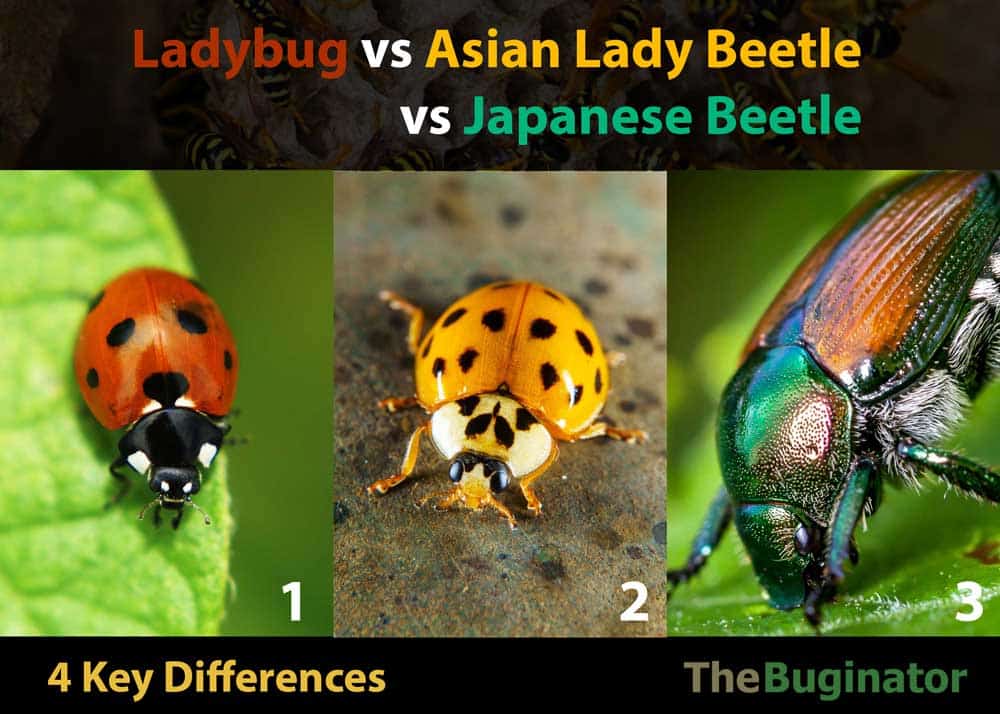
Here are the specifics of these three types of beetles.
Table of Contents
Ladybug Overview
- Scientific name: Coccinellidae
- Common names: Ladybug, lady beetle, ladybird, lady fly
- Range: Worldwide
- Size: 0.03 to 0.71 inches (0.8 mm to 18 mm)
- Habitat: Grasslands, forests, cities, suburbs, and along rivers
- Appearance: Typically, Ladybugs are round and relatively small. The colors on the wing covers (elytra) can be orange, red, or yellow and will often be covered in black dots. Some species are entirely black. Ladybugs have black heads, legs, and antennae.
- Risk to humans: Ladybugs can bite and pinch, leaving a mark. But they are not venomous, so there is limited risk. They are relatively poisonous and have mildly toxic properties.

A ladybug’s bright colors communicate to potential predators that they’re dangerous and not worth eating.
When under distress or disturbed in any way, ladybugs can emit a chemical from their knees that have an awful odor to ward off and keep enemies at bay.
Experienced predators will learn over time that prey with color combinations like the ladybug is unappetizing and potentially dangerous. This color scheme is so effective that ladybugs that are not unappetizing go on to mimic the colors of the ladybugs, which are poisonous.
Ladybugs are virtually everywhere globally, but in particular, they are found in temperate climates. You can observe ladybugs in gardens, forests, and vacant lots with many weeds and weed patches.
Mature ladybugs may eat up to 75 aphids every day. Ladybugs prey on insects such as mites, thrips, and fruit flies. Interestingly, not all ladybugs are insectivores; however, the ones who are can be beneficial to a garden because they won’t damage the crop as they feed on insects. Their ability to remove pests can stand in for costly pesticides.
As a result, ladybugs are a commodity you can purchase from many suppliers. Over 100 species of ladybugs now inhabit California.
Ladybugs are beneficial insect predators.
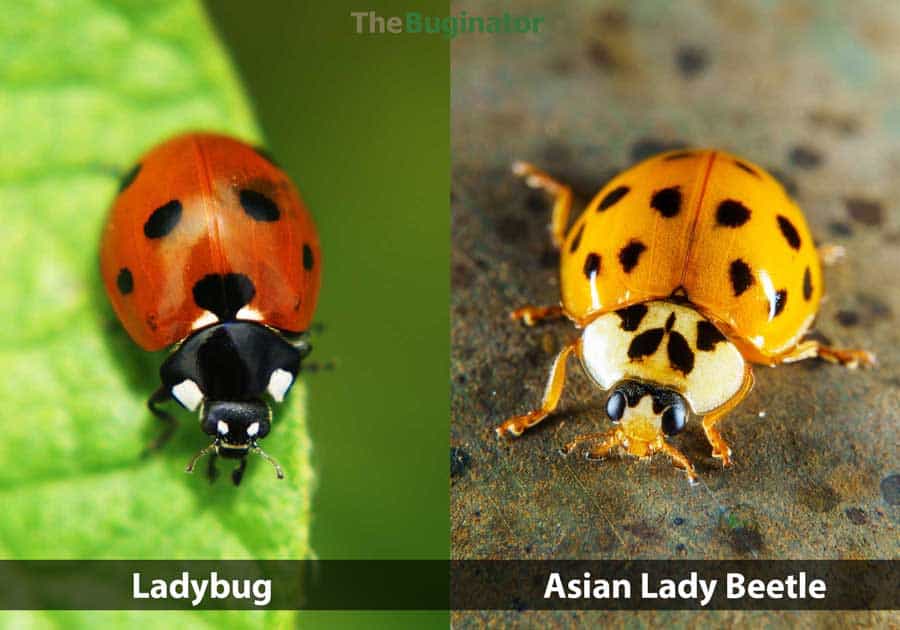
Asian Lady Beetle Overview
Asian lady beetles are often orange-tinted and look very similar to the common ladybug.
The Harmonia axyridis is one of the most variable species in the world, with a broad color range. These colors in varying shades include orange, red, and black. And the number and color of spots is also highly variable.
- Scientific name: Harmonia axyridis
- Common names: Harlequin, multicolored Asian, Halloween beetle, Asian ladybug
- Range: Native to East Asia. Introduced around the world, including Europe, Africa, North America, South America
- Size: 0.2 to 0.33 inches (5.5 to 8.5 mm) in length
- Habitat: Forests, grasslands, farms, cities
- Appearance: Asian ladybugs look very similar to the common ladybug. The body shape is domed. They are often either orange or red, with black spots (from zero to 22 spots) of varying sizes.
- Risk to humans: Risk level is low, but they can harm humans and pets when they release their self-defense liquid called hemolymph. Ladybugs can attempt to pinch you with their mandibles. If successful, they can leave a mark. Ladybugs don’t have venom.
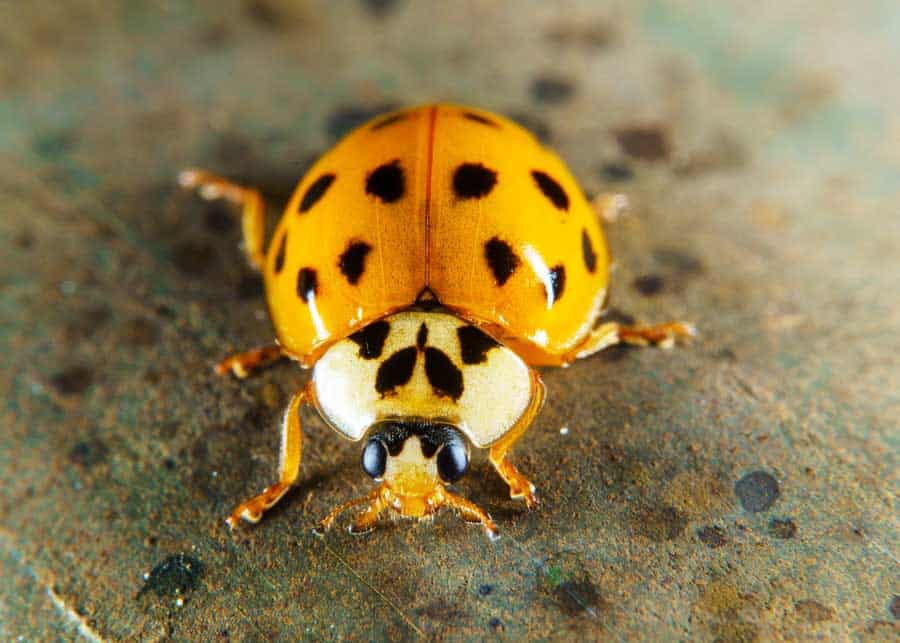
The pronotum is often white with black spots or patterns. Spots often form an “M” pattern, but sometimes is it mostly black.
Are Asian Lady Beetles Poisonous?
They are potentially poisonous and possibly allergenic to humans.
The poison that ladybugs produce is a smelly liquid they secrete when disturbed. The yellowish red liquid is actually their blood. You’ll see this if you squish one or if it feels threatened in another setting.
Are Asian ladybeetles dangerous to pets?
Asian lady beetles release hemolymph, a stinky and poisonous fluid. This self-defense mechanism is usually potent enough to repel pets from consuming them.
Dog and beetle conflicts are so rare, that aside from anecdotal reports (like Bailey’s), a lone formal published paper exists on the subject. In this case, the patient had 16 Asian lady beetles embedded in the mucous membrane covering the hard palate
PetMD.com
Japanese Beetle Overview
- Scientific name: Popillia japonica
- Common names: Japanese beetle
- Range: East Asia, Europe, North America
- Size: 0.6 inches (15 mm) in length
- Habitat: Forests, grasslands, farms, cities
- Appearance: The elytra (wing covers) are bronze in color, and the body is metallic green and shiny. It has six small hair tufts running along its side.
- Risk to humans: There has been no evidence to suggest that these beetles bite. However, they will attempt to pinch you with their mandibles. Even still, their mandibles are too weak to damage human skin, let alone harm you.
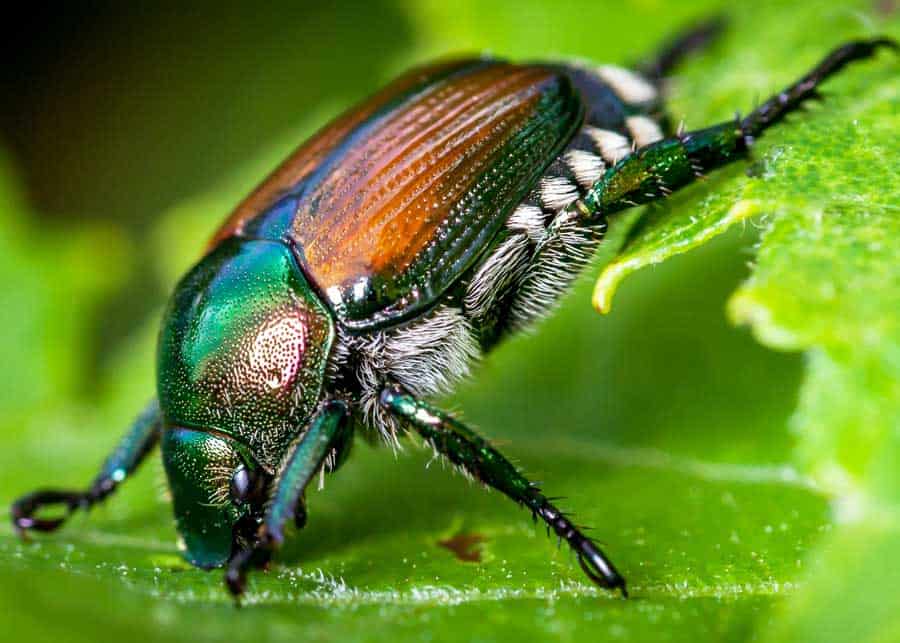
The Japanese beetle is the most destructive insect pest in the eastern United States as far as gardens and landscapes are concerned.
This beetle was first discovered in the country in 1916 in the USA near Riverton, New Jersey. They arrived in a nursing stock from Japan. This beetle infestation methodically expanded south and west to eventually cover most of the eastern half of the United States.
Japanese beetles are an established milkweed pest.
Ladybug vs Japanese Beetle
Japanese beetles are not a type of ladybug. They are a large species of scarab that is invasive and very damaging in western Europe and North America.
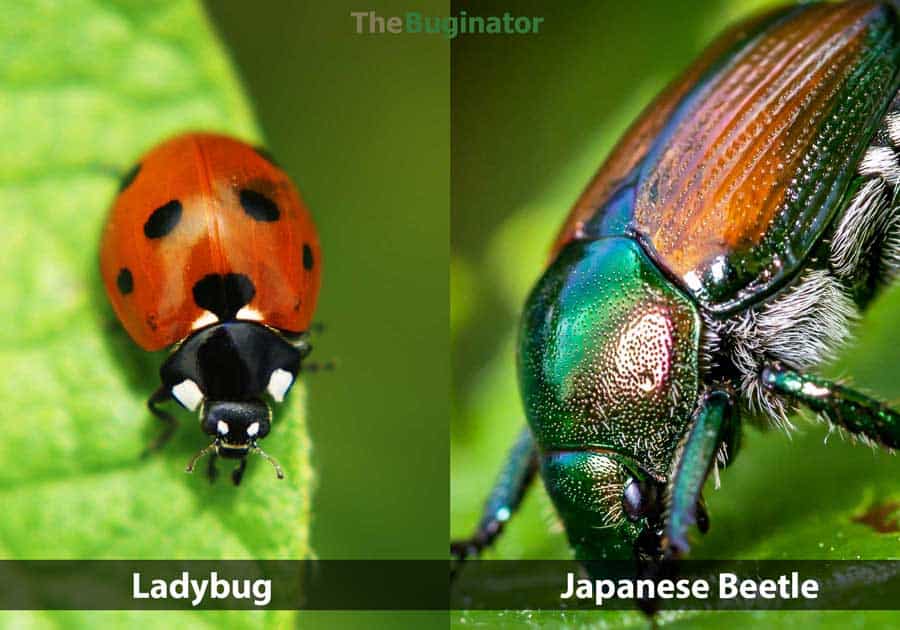
Asian Lady Beetle vs Japanese Beetle
Because of nicknames and similar sounding common names, insect names can be confusing.
Because of both being called beetles and having geographically similar names, Asian lady beetles and Japanese beetles get confused often.
But Asian lady beetles and Japanese beetles are not the same. And the names are not interchangable.
As you can see in the comparison photo, they don’t look alike either.
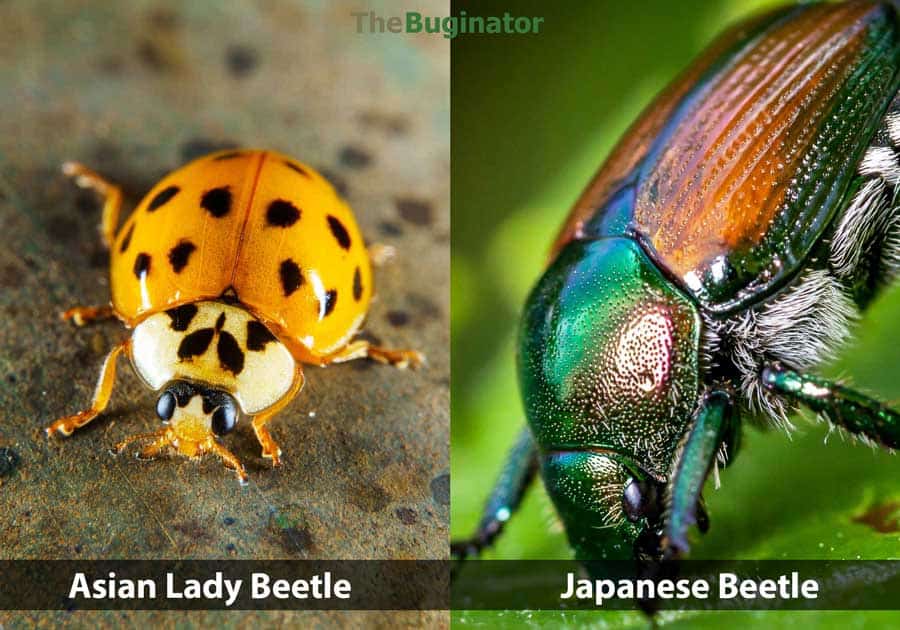
Asian Lady Beetles
Asian lady beetles are a type of ladybug, being of the Coccinellidae family. This includes more than 6000 species.
Asian lady beetles were imported to England and North America to help control pests and mildew on crops.
The harlequin ladybird (as Asian lady beetles are also known) is considered an invasive species in North America. They now outcompete many similar native species.
Japanese Beetles
Japanese beetles are classified into the Scarabaeidae family. It is a type of scarab beetle, like the rhino beetle.
They first appeared in the United States in 1916. Since then, they have spread across Canada and the United States.
In North America and Europe, Japanese beetles are very destructive. They are pests to more than 300 plant species, consuming leaves and fruit. Larvae feed on grass roots underground.
Learn more in our Guide to 6-Legged Insects
How to Get Rid of Japanese Beetles
Controlling Japanese beetles is a problematic endeavor. Intangibles such as diligence, persistence, and grit to continue are vitally necessary to rid yourself of them. This is especially true because they emerge every single day for several weeks.
You should remove beetles as soon and as often as possible to mitigate the attraction of more beetles to the area. Remove these beetles early in the morning while they are very slow and sluggish. Collect the beetles into a bucket of water with soap therein and then throw it away.
Other effective methods:
- Neem oil: it contains potassium bicarbonate, which gets passed to the larvae through the adult beetles feeding on the plants; the larvae die before becoming adults
- Geraniums: Japanese beetles get paralyzed temporarily by a substance in geraniums, leaving them susceptible to other predators
Essential oils can make a great bug repellent.
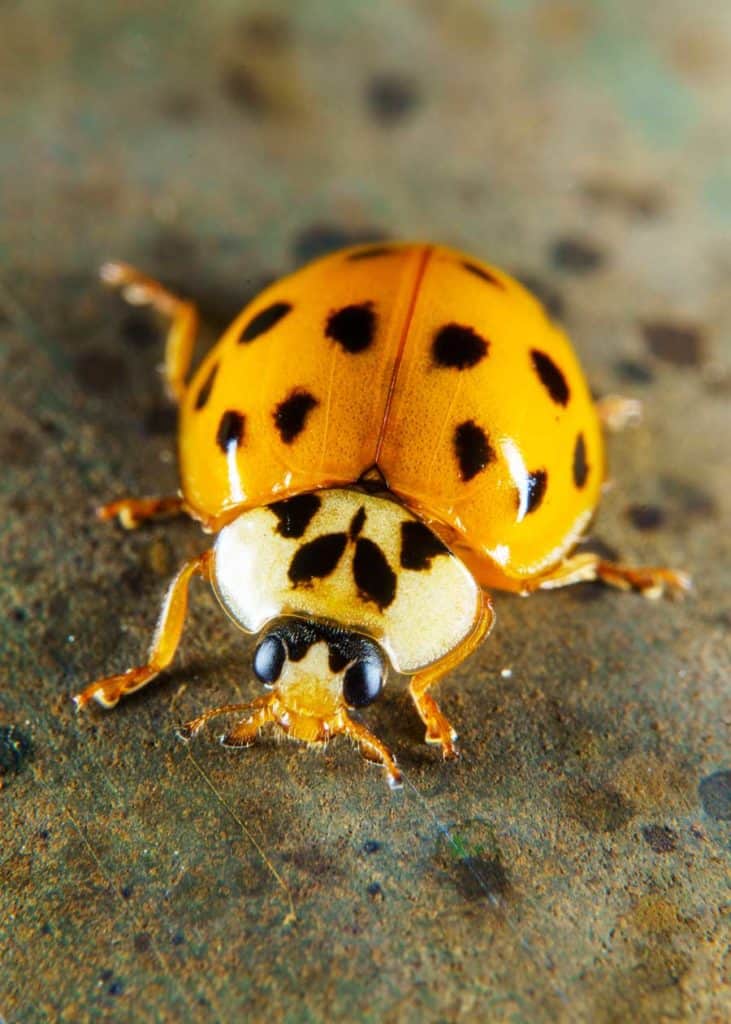
4 Key Differences: Ladybug vs Japanese Beetle
Here are the primary differences between a ladybug and a Japanese beetle:
1. Appearance
The ladybug that most people think of is the most common species, and it generally has up to 13 spots on its bright red or reddish-orange forewings.
The traditional ladybug, also called the convergent ladybug, features two white lines that meet behind their head, which is how they got the name convergent.
On the other hand, the Japanese beetle has a metallic green-blue head with a copper/bronze back, tan-colored wings, and short white tufts of hair on either side of the abdomen. You can always find lines that go inward and form a “W” or an “M” behind their head.
Additionally:
- Japanese beetles are typically larger than ladybugs
- Japanese beetles don’t have black spots on their wings
- Japanese beetles are longer in shape, while ladybugs have more of an oval and rounded shape
2. Gardens
Ladybugs are considered beneficial insects that help gardeners by eating pesky plant-destroying insects. They don’t cause any damage to your plants, but they help immensely with keeping pests at bay.
Japanese beetles are an invasive species that farmers and gardeners have been trying to eradicate for years as they wreak havoc on crops and the agricultural industry.
3. Diet
It is easy to tell when the insects damaging your leaves are the Japanese beetles because of their distinct leaf-eating pattern. They don’t like the veins in the leaves, so it makes the leaves look lacy once they’re finished.
Both the ladybug and the Japanese beetle eat aphids that can damage your vegetables and crops, fruits, and flowers, but Japanese beetles are known as invasive species.
The convergent ladybug is a beneficial insect that only consumes bugs that are generally problematic for gardeners. For this reason, they get collected and used as a natural form of pest control.
Japanese beetles feed on more than 300 plants, flowers, leaves, wounded, and overripe fruits. They love raspberries, cherries, roses, magnolias, and other fruits with fairly tough exteriors. They tend to eat in large groups, beginning at the top and going down to the bottom of a plant in a swarm. If it’s sunny and warm outside, it’s easy to catch these pests in action.
4. Location
You can find ladybugs pretty much anywhere around the world if there is a food source, and the weather isn’t too cold. They are most commonly found in North America, Europe, and South America.
Japanese Beetles are native to Japan and East Asia as a whole. They cause infestation problems in states that are to the east of the Mississippi River, and they have also been seen in Switzerland and Italy.
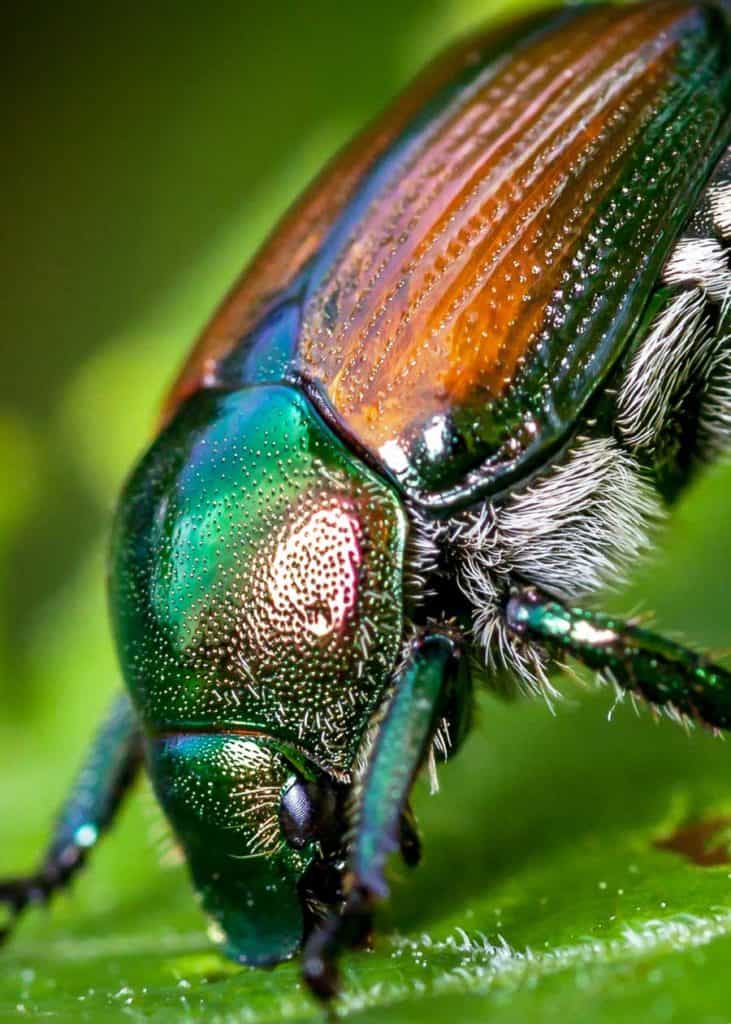
More reading: Are Bugs and Insects the Same? 3 Key Differences
Your Turn
Have you seen any of these insects around your home? Let me know below!
- About the Author
- Latest Posts
Bryan Haines is a co-founder and writer at The Buginator. And is working to make it the best resource for taking back the outdoors from biting, stinging pests.
He also blogs about travel at Storyteller.Travel and photography at Storyteller Tech. Bryan is a partner at Storyteller Media, a publishing company he runs with his wife, Dena.
